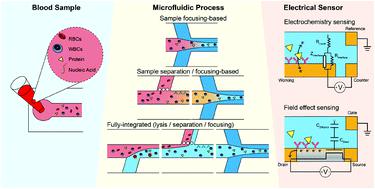当前位置:
X-MOL 学术
›
Anal. Methods
›
论文详情
Our official English website, www.x-mol.net, welcomes your
feedback! (Note: you will need to create a separate account there.)
Recent advancements in microfluidics that integrate electrical sensors for whole blood analysis.
Analytical Methods ( IF 2.7 ) Pub Date : 2020-06-11 , DOI: 10.1039/d0ay00413h Da-Han Kuan,Nien-Tsu Huang
Analytical Methods ( IF 2.7 ) Pub Date : 2020-06-11 , DOI: 10.1039/d0ay00413h Da-Han Kuan,Nien-Tsu Huang

|
Whole blood analysis reveals crucial information about various physiological and pathological conditions, including cancer metastasis, infection, and immune status, among others. Despite this rich information, the complex composition of whole blood usually required multiple sample preparation steps to purify targeted analytes. Traditionally, whole blood preparation processes, including centrifugation, lysis, dilution, or staining, are usually manually operated by well-trained technicians using bench-top instruments. This preparation can require a large blood volume and cannot be directly integrated with detection systems. Recently, various studies have integrated microfluidics with electrical sensors for whole blood analysis, with a focus on cell-based analysis, such as cell type, number, morphology, phenotype, and secreted molecules. These miniaturized systems require less sample and shorter reaction times. Besides, the sample processing and analysis can be fully integrated and automated with minimal operations. We believe these systems can transfer the current whole blood analysis from hospitals or laboratories into clinics or home settings to enable real-time and continuous health condition monitoring in point-of-care settings.
中文翻译:

集成电子传感器进行全血分析的微流控技术的最新进展。
全血分析揭示了有关各种生理和病理状况的重要信息,包括癌症转移,感染和免疫状况等。尽管有如此丰富的信息,但全血的复杂成分通常需要多个样品制备步骤才能纯化目标分析物。传统上,全血制备过程(包括离心,裂解,稀释或染色)通常由训练有素的技术人员使用台式仪器进行手动操作。这种制备可能需要大量的血液,并且不能直接与检测系统集成。最近,各种研究已经将微流体技术与电子传感器集成在一起,用于全血分析,重点是基于细胞的分析,例如细胞类型,数量,形态,表型和分泌分子。这些小型化系统需要更少的样品和更短的反应时间。此外,样品处理和分析可以完全集成并以最少的操作实现自动化。我们相信,这些系统可以将当前的全血分析从医院或实验室转移到诊所或家庭环境中,以实现即时,连续的即时医疗状况监测。
更新日期:2020-07-09
中文翻译:

集成电子传感器进行全血分析的微流控技术的最新进展。
全血分析揭示了有关各种生理和病理状况的重要信息,包括癌症转移,感染和免疫状况等。尽管有如此丰富的信息,但全血的复杂成分通常需要多个样品制备步骤才能纯化目标分析物。传统上,全血制备过程(包括离心,裂解,稀释或染色)通常由训练有素的技术人员使用台式仪器进行手动操作。这种制备可能需要大量的血液,并且不能直接与检测系统集成。最近,各种研究已经将微流体技术与电子传感器集成在一起,用于全血分析,重点是基于细胞的分析,例如细胞类型,数量,形态,表型和分泌分子。这些小型化系统需要更少的样品和更短的反应时间。此外,样品处理和分析可以完全集成并以最少的操作实现自动化。我们相信,这些系统可以将当前的全血分析从医院或实验室转移到诊所或家庭环境中,以实现即时,连续的即时医疗状况监测。











































 京公网安备 11010802027423号
京公网安备 11010802027423号